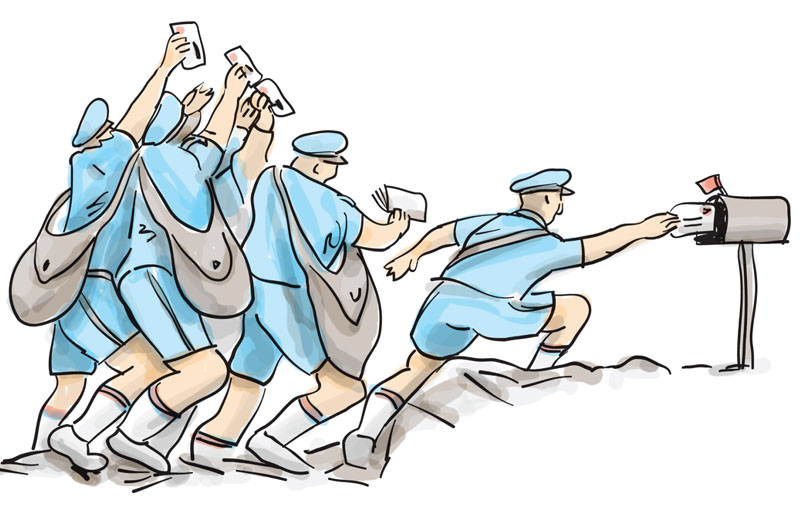For two holiday seasons in the 1960s, I worked as what the post office called a “Santa’s Helper” mailman. It was hard work carrying those 30-pound leather bags, but it helped me appreciate the post office. People would actually stand beside their mailboxes waiting for me to hand over the mail. And I handed over a ton of it.
The post office was the only game in town when it came to written communication back then. That is no longer the case. Last week I got more than 400 emails, and 20 or so of my Facebook “friends” posted chatty updates with photos. But here’s what showed up in my physical mailbox during that same time: 18 unsolicited catalogs (including four from Orvis, which may tell you something about my wardrobe), two magazines, two invitations to living trust seminars (which may tell you something about my age), three classified advertising throwaways and enough grocery store coupons and fliers to choke a horse. I only got three pieces of mail aimed specifically at me, and one of them was a bill; another was a plea from my bank to go paperless.
I’m not atypical. According to a recent survey reported in the New York Times, stamped mail, which has earned the contemptuous sobriquet “snail mail,” is down almost 50 percent since 2001, and it continues to drop by about 8 percent to 10 percent a year.
But if snail mail is an endangered species, what about the health of my old employer, the company charged with delivering it? Not good at all, I’m afraid. The U.S. Postal Service hasn’t shown a penny of profit since 2006, and according to a postmaster general report last year, cumulative Postal Service debt may grow as high as $238 billion by the end of this decade.
According to the Postal Service’s own figures, it is the second-largest civilian employer in the country. It has 215,000 vehicles, the largest nonmilitary fleet of vehicles in the world. And despite being a federal government entity operating under the executive branch, it receives no tax dollars.
Since 1971, the USPS has been a quasi-independent operation, with considerable autonomy in managing its affairs. But as is apparent all too often, that autonomy has limits. Last summer the USPS sent up a trial balloon suggesting it might end Saturday delivery, saving billions of dollars. The fate of that trial balloon made the Hindenburg look like a perfect landing.
The American Postal Workers Union, which can be as tough as a two-dollar steak, waded in immediately, insisting that people in remote areas of the country would be hit hard by such a move. Montana Sen. Jon Tester, a great favorite of labor, agreed and said Saturday delivery was needed in his state so rural folks could “get the things they need.” Why farmers and ranchers in Montana can’t wait until Monday to get their Orvis and Lands’ End catalogs was not explained. The American Postal Workers Union is also on record disputing the idea that “hard-copy mail is destined to be replaced by electronic messages.” LOL.
U.S. Postmaster General Patrick Donahoe knows better. Not only should Saturday delivery be eliminated, he says, but over the next 10 years, we should go to three-day-a-week mail delivery, which would save hundreds of billions of dollars.
Very soon, the House Committee on Oversight and Government Reform will pass judgment on a proposed bill by its chairman, Rep. Darrell Issa, R-Calif. The bill would end Saturday delivery and eventually reduce the Postal Service workforce by as many as 220,000 jobs over the next 10 years. If the bill makes it all the way to the House floor, it won’t be an easy sell to a group struggling with ways to create jobs, not eliminate them.
But the writing is on the Internet wall. Either Congress is going to have to eliminate some of the postal services that are more traditional than necessary, or it will very shortly have to step in to subsidize a delivery system that is more and more devoted to what we used to call “junk mail” — a subsidy that could make the bailout of General Motors look like a bargain. And unlike General Motors, which has a chance of selling more cars, the total volume of mail will continue to shrink every year.
The USPS provides an essential service to all Americans. Moreover, it is one of the few such services specifically provided for in the U.S. Constitution. But Donahoe and Issa are right: The frequency and scope of that service needs to be streamlined. Even Santa’s Helper realizes that we can get along very well with three-day mail delivery.
Send questions/comments to the editors.



Success. Please wait for the page to reload. If the page does not reload within 5 seconds, please refresh the page.
Enter your email and password to access comments.
Hi, to comment on stories you must . This profile is in addition to your subscription and website login.
Already have a commenting profile? .
Invalid username/password.
Please check your email to confirm and complete your registration.
Only subscribers are eligible to post comments. Please subscribe or login first for digital access. Here’s why.
Use the form below to reset your password. When you've submitted your account email, we will send an email with a reset code.